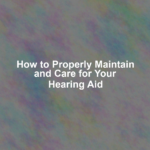Nearly 15% of adults in the United States report some trouble with hearing, and for many, hearing aids are a vital tool that reconnects them with the world. As you rely on this small, yet sophisticated device every day, itG??s crucial to keep it functioning at its best.
Proper maintenance and care not only extend the life of your hearing aid but also ensure that it delivers the clearest sound possible. From the daily cleaning routine to safeguarding it against moisture, there are several straightforward steps you can take to prevent common issues.
YouG??re also likely aware that battery care and regular performance checks are part of the equation, but itG??s the finer details that can make a significant difference. Unveiling these nuances, alongside when to seek professional servicing, could save you from unexpected hiccups and preserve the quality of your auditory experience.
Stay with us as we unpack these essentials, and youG??ll discover how simple habits can lead to lasting benefits for your hearing aidG??s performance.
Daily Cleaning Routine
To ensure your hearing aidG??s performance, itG??s crucial to adopt a daily cleaning routine that removes earwax and debris. Earwax is a common cause of diminished sound quality and can even damage the device if not addressed. YouG??ll want to use a soft, dry cloth to gently wipe the surface of your hearing aid every day. DonG??t use water, alcohol, or other cleaning solvents as they can harm the delicate components.
Focus on the microphone and speaker ports where wax tends to accumulate. Specialized tools like wax picks or brushes provided by your audiologist can help clear these areas without causing damage. Be gentle to avoid pushing wax deeper into the device.
At night, when youG??re not wearing your hearing aid, open the battery compartment. This not only saves battery life but also airs out the device, reducing the effects of moisture. Remember, moisture is an enemy to your hearing aidG??s electronics.
Regularly check for any signs of wear or damage. If you spot anything unusual, schedule a visit with your hearing care professional. They can provide a deeper clean or repairs as needed. By keeping up with these simple cleaning habits, youG??ll prolong the life of your hearing aid and ensure it works effectively for your daily needs.
Moisture Protection Measures
While keeping your hearing aid clean is essential, itG??s equally important to protect it from moisture, which can cause serious damage to its internal components. Moisture can come from a variety of sources: rain, sweat, and even humidity. To combat this, make sure youG??re storing your hearing aid in a dry place when youG??re not wearing it. A dehumidifier designed for hearing aids is a fantastic investment, drawing out moisture each night while you sleep.
If youG??re caught in the rain or sweat during exercise, itG??s crucial to dry your hearing aid as soon as possible. Wipe it gently with a dry, soft cloth, ensuring you donG??t press too hard on the microphone or speaker areas. Avoid using a hairdryer or any direct heat source to dry your hearing aid, as this could cause more harm than good.
Lastly, consider using a hearing aid sweatband when youG??re active or in moist environments. This protective cover helps to shield the device from excessive moisture. Remember, consistent care is key to extending the life of your hearing aid. By taking these moisture protection measures, youG??ll ensure that your device performs optimally for years to come.
Battery Care and Replacement
Properly maintaining your hearing aidG??s battery not only ensures optimal performance but also extends the lifespan of your device. ItG??s crucial to understand when and how to replace your batteries. Typically, hearing aid batteries last between 5 to 14 days, depending on usage, size, and hearing aid type. YouG??ll know itG??s time for a change when sounds become faint or distorted, or your device stops working altogether.
When replacing your batteries, handle them with clean, dry hands to prevent damage and ensure they last as long as possible. Also, make sure youG??re using the correct battery sizeG??your hearing aid wonG??t function properly with the wrong type.
To maximize battery life, turn off your hearing aid when youG??re not using it. Store spare batteries at room temperature, and keep them in their original packaging to avoid short-circuiting. Bear in mind that extreme temperatures can affect battery performance, so donG??t leave them in places like a hot car or freezer.
Regular Performance Checks
Regularly checking your hearing aidG??s performance is essential to ensure itG??s functioning optimally. Without routine checks, you mightnG??t notice gradual declines in performance that can affect your hearing experience. HereG??s how you can carry out your own performance checks:
-
Listen for Feedback: Put the hearing aid in your ear and cup your hand over it. If you hear a whistling sound, there may be an issue with the fit or a buildup of earwax.
-
Check the Sound Quality: Wear your hearing aids in a familiar environment and pay attention to the clarity of sounds. If youG??re struggling to hear things that were once clear, it might be time for a professional tune-up.
-
Inspect the Earwax Filter: Earwax can clog your hearing aid and muffle its performance. Make sure youG??re regularly checking and, if necessary, changing the wax filter.
-
Test the Batteries: Even if your batteries are new, they can be defective or weak. Test them with a battery tester or listen for the low battery indicator to ensure theyG??re providing enough power.
Professional Servicing Schedule
How often should you schedule professional servicing for your hearing aid to ensure it remains in top condition? ItG??s vital to have a regular schedule for professional check-ups, typically once every six months to a year. Just like youG??d see a dentist for a toothache, you should visit your audiologist or a hearing aid specialist if you suspect any issues with your device.
During these visits, professionals can give your hearing aid a thorough cleaning that goes beyond your daily routine. TheyG??ll check for earwax blockages, replace any worn-out parts, and ensure the software is up-to-date. They can also assess whether your hearing aid is still well-suited to your current level of hearing loss, as this can change over time.
Remember, catching problems early can save you from bigger issues down the line. You mightnG??t notice a gradual decline in performance, but an expert will. So, donG??t skip these appointmentsG??theyG??re essential for keeping your device functioning at its best.
If youG??re active, sweat a lot, or live in a humid climate, you might need to go in more often. When in doubt, itG??s better to check in sooner rather than later. Keep your hearing aid in top shape, and itG??ll keep you tuned in to the sounds of life.
Conclusion
YouG??ve got this! Keep your hearing aid in top-notch condition by sticking to your daily cleaning routine and safeguarding it from moisture.
DonG??t forget to regularly check your batteries and replace them when needed. Stay on top of performance checks to catch any issues early.
And remember, schedule professional servicing to ensure everythingG??s working perfectly. Your proactive care means your hearing aid will continue to support your daily life seamlessly.










